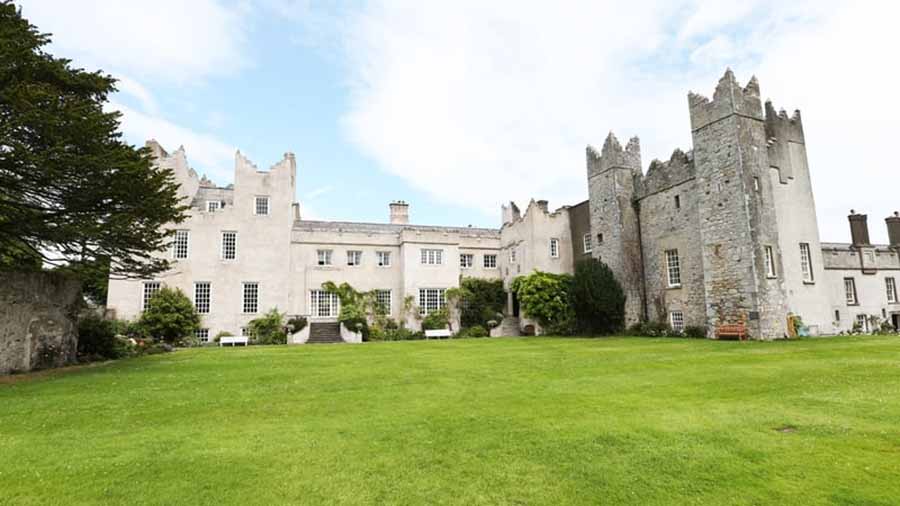
Tetrarch Capital has proposed a 99-year lease deal with Fingal County Council for Howth Castle to develop a tourism destination akin to Malahide Castle.
The development follows a series of planning setbacks. Iin 2022, the council blocked Tetrarch’s bid to rezone 16.5 acres for 150 affordable homes and a retirement community, citing the need to protect the estate’s green spaces under its Special Amenity Area Order (SAAO). These setbacks highlight a tension between development and conservation, a recurring challenge for historic sites under modern pressures.
Tetrarch Capital, a real estate investment and development firm, acquired Howth Castle and its 470-acre estate in 2019 from the Gaisford St Lawrence family for an undisclosed sum. This marked the end of an 840-year tenure by the family, a significant shift for a property steeped in history. Tetrarch, known for managing assets like Mount Juliet Estate and Citywest Hotel, aimed to transform the estate into a major tourism destination, drawing inspiration from successful models like Malahide Castle.
Malahide Castle, also in Fingal County, has been maintained as a public heritage site under the stewardship of Fingal County Council since its sale to the state by the Talbot family in 1975. It now serves as a popular tourist attraction, complete with guided tours and preserved gardens, offering a blueprint for what Howth Castle could become.
The developer encountered planning setbacks regarding its objectives for the historic site. However, these ambitions have faced planning setbacks. In 2023, Fingal County Council approved the €10m redevelopment but imposed conditions, such as limiting parking spaces to 151 (later adjusted to 188 by An Bord Pleanála), which Tetrarch argued compromised the project’s viability. A proposed new road to manage increased visitor traffic was rejected as “unnecessary” and contrary to the Fingal County Development Plan 2023-2029, which prioritizes sustainable transport and preserving high-amenity areas like Howth.
History of Howth Castle

Howth Castle has a rich history spanning over 800 years. Howth Castle, perched on the rugged peninsula of Howth in County Dublin, Ireland, boasts a history stretching over 800 years, intertwining legend, conquest, and architectural evolution. Its story begins in the late 12th century, rooted in the Norman invasion of Ireland, and unfolds through centuries of ownership by the St Lawrence family, whose descendants held the estate until its sale in 2019.
The origins of Howth Castle are tied to Almeric Tristram, a Norman knight who arrived in Ireland as part of the second Norman invasion in 1177 alongside John de Courcy with the reputation of having been a descendant of one of the knights of King Arthur’s Round Table. Legend claims that on August 10, the feast day of Santt Lawrence, deacon and martyr (not Saintt Laurence O’Toole), Almeric defeated local forces near the Evora Bridge by Dublin Bay, near where Howth railway station is today, securing the Howth peninsula as his prize. In gratitude—or perhaps as a nod to divine favor—he adopted the name St Lawrence, establishing a family lineage that would endure for over eight centuries. The first recorded fortification on the site, likely a timber motte-and-bailey castle, was erected around 1180 near the present castle’s location, marking the beginning of its defensive and symbolic role.
The earliest stone structure emerged later, with historical records pointing to a castle built by the St Lawrence family around 1235. However, the oldest surviving parts of the current castle date to around 1450, reflecting a more substantial medieval rebuild. This iteration featured a fortified keep, designed to withstand local threats and assert control over the strategically vital headland overlooking the Irish Sea. Over time, the castle evolved from a military stronghold into a family seat, with its architecture adapting to changing needs. In 1576, a significant event etched the castle into Irish lore: Grace O’Malley, the famed pirate queen, visited after being rebuffed by Christopher St Lawrence, the 10th Baron of Howth, who was dining and refused her entry. In retaliation, she abducted his heir and extracted a promise of hospitality—symbolized by an extra place setting at meals—that the family honoured for generations.
By the 18th century, the medieval structure had given way to a more domestic form. Much of the castle standing today was rebuilt in 1738, transforming it into a grand residence with Georgian influences. In 1911, the renowned architect Sir Edwin Lutyens added his distinctive touch, designing extensions that blended seamlessly with the older stonework, including a new entrance and enhancements to the estate’s gardens and rhododendron walks. These changes reflected the St Lawrence family’s status as landed gentry, with the castle serving as both a home and a statement of heritage amid its sprawling 470-acre estate.
For over 800 years, the Gaisford St Lawrence family—as the lineage became known after inheriting additional estates—maintained ownership, making Howth Castle one of Ireland’s longest continuously inhabited family homes. The estate, encompassing woodlands, a demesne, and coastal views, was a microcosm of Irish history, weathering Viking raids, English rule, and the shifting tides of independence.
Its cultural significance grew with tales like that of the stolen “Book of Howth,” a medieval manuscript taken by Christopher St Lawrence in the 16th century, and its association with figures like W.B. Yeats, who drew inspiration from its romantic aura.
The castle’s long chapter under the St Lawrence family ended in 2019 when financial pressures, including inheritance tax and maintenance costs estimated at €1.5m million annually, prompted its sale to Tetrarch Capital.
The exact price remains undisclosed, but the transaction marked the first time since 1177 that the estate left family hands. Tetrarch has since aimed to reimagine Howth Castle as a tourism destination, proposing developments like restaurants, retail spaces, and a hotel, though these plans have faced planning challenges from Fingal County Council, which oversees the area.
Today, Howth Castle stands as a testament to its medieval roots and layered history. While its 1450 keep and Lutyens’ additions remain, its future balances preservation with reinvention, reflecting Ireland’s ongoing negotiation between past and present.




